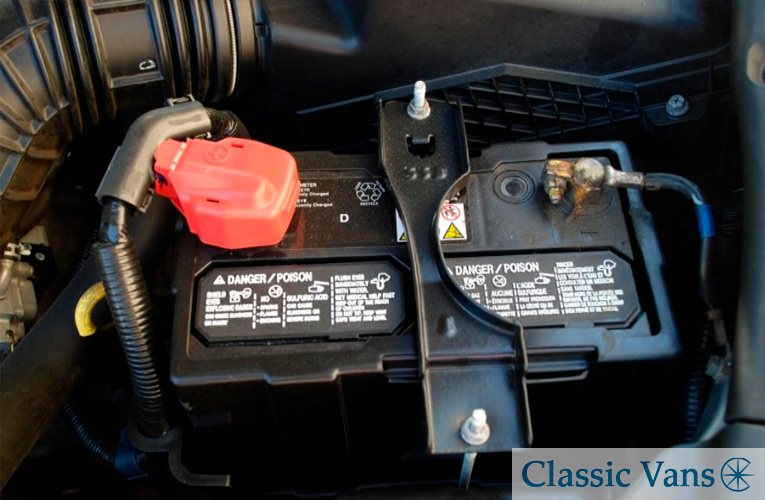What you need to know about RV & motorhome batteries
As a motorhome or RV owner, it’s important to be well-versed in RV battery systems. You never know when your battery may need to be replaced or recharged, leaving you stranded on the side of the road wondering what to do.
Typically, there are two batteries in a standard class B RV or motorhome: one is used to start the engine and another powers the electrical devices inside the living space. In this article, we’ll primarily discuss the second type of battery.
If you own a pop-up camper or trailer that gets towed by another vehicle, these are typically equipped with batteries as well and require routine and ongoing maintenance to ensure they last for many years.
How Motorhome Batteries Work
RV and motorhome batteries are lead acid batteries, meaning they have several cells within the unit that are connected in series. Each cell produces approximately 2.1 volts, so a traditional 12-volt battery with six cells has an output voltage of around 12.6 volts. This is the approximate voltage reading you should get if you test the voltage while the batteries are at rest and not being used.
Lead acid batteries store electrical power so that you can use it to power your vehicle’s interior lights, appliances, air conditioning, and engine. Some long-term travelers supplement their battery usage with a propane system or an inverter generator so they don’t have to rely on electric power as much.
Also referred to as “house” batteries or “deep cycle” batteries, they’re designed to provide a steady amount of current over a long period of time. A deep cycle battery has thicker internal plates and are designed to be deeply discharged and recharged repeatedly.
What’s an Amp Hour Rating?
Deep cycle batteries are rated in amp hours. An amp hour rating essentially tells you how many amps the battery can deliver over a certain number of hours before the battery is completely discharged.
For example, a battery that can deliver 5 amps for 20 hours before it’s discharged would have a 100 amp hour rating. Alternatively, it could deliver 20 amps over a period of 5 hours.
5 amps x 20 hours = 100 amp hours
Note: A complete discharge doesn’t mean it goes from 100 percent down to zero. Rather, it means the battery goes from a full charge (100 percent) to 50 percent, and then back up to 100 percent again.
What’s the Life Expectancy of My Battery?
It depends. How often the battery is used, how well it’s maintained, how it’s stored, and how often it’s discharged/recharged are all contributing factors to a battery’s life span. Generally though, motorhome and RV batteries last anywhere from one year to many years.
4 Tips for Extending Your Battery’s Life Span
1. Cycle It No Lower than 50 percent
In most cases, the deeper the battery cycles, the longer it lasts — but you never want to let it go below 50 percent. Effectively, this means you’ll never want to make use of a battery’s full amp hours. You should cut this rating in half if you want to maximize its lifespan.
If a battery is discharged to 50 percent every day, it will last twice as long as one that’s cycled to 80 percent. Life expectancy of a battery also depends on how quickly it’s recharged after its discharged. The sooner you’re able to recharge the battery, the better.
2. Maintain Proper Water Levels
One of the easiest ways to take care of your battery is to make sure its water levels are at the correct height. Batteries should always be watered after charging. The water level should be kept ¼ an inch below the bottom of the fill tube in the cell cover. Always use distilled water to refill batteries.
3. Keep Your Batteries Clean
For some reason, RV batteries tend to attract dirt, grease, and grime more than usual. This can decrease the lifespan of the battery over time. Some RVs and motorhome have covers for the batteries to keep the rain and other debris out.
Here are some basic tips to follow for keeping your batteries clean:
- Check that all vent caps are tightly in place.
- Clean the battery top with a solution of baking soda and water to remove corrosion at the terminals.
- Clean battery terminals, posts, and the inside of the cable clamps with a post and clamp cleaner.
- Keep the area around the batteries clean and dry.
Note: Always disconnect the battery from the engine before touching or cleaning it. Never turn the vehicle on while cleaning.
4. Proper Storage Methods
Periods of inactivity are harmful for lead acid batteries because they’re meant to be regularly used (charged, recharged, discharged, etc.). However, if you must winterize your RV or put it away for several months, be sure to properly store the battery. Above all, extreme high or low temperatures should be avoided as both freezing and excessive heat will cause irreparable damage to your battery’s functionality.
Follow these steps for proper battery storage:
- Completely charge the battery.
- Store it in a cool, dry location protected from the elements. A dry basement is ideal for this.
- During storage, monitor the voltage. Batteries in storage should be given a boost charge when they reach 70 percent charge or less.
- Completely charge the battery before reactivating.
When you follow these procedures for battery maintenance and storage, you can help prolong its life and save money. Take care of your RV or motorhome and they’ll serve you well for many trips to come.
